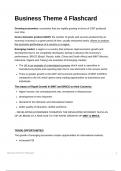Business Theme 4 Flashcard
Growing economies: economies that are rapidly growing in terms of GDP produced
over time.
Gross domestic product (GDP): the number of goods and services produced by an
economy (country) in a given period of time, usually measured yearly. Allows to analyse
the economic performance of a country or a region.
Emerging market: a region or a country that achieves rapid economic growth and
development but is not completely developed, aiming to advance the economy's
performance. BRICS (Brazil, Russia, India, China and South Africa) and MINT (Mexico,
Indonesia, Nigeria and Turkey) are examples of Emerging markets.
The UK is an example of a developed economy which used to specialise in
manufacturing foods and exporting them but is now dominant in the service sector.
There is greater growth in the GDP and economic performance of MINT & BRICS
compared to the UK which opens many trading opportunities to businesses and
individuals.
The Impact of Rapid Growth In MINT and BRICS on their Countries
higher income, low unemployment rate, investment in infrastructure
development of new industries
demand for the domestic and international market
better quality of education, skilled workforce-
- DEVELOPING ECONOMIES THREATEN THE DEVELOPED ECONOMY SUCH AS
OF UK BEING AT A RISK DUE TO THE RAPID GROWTH OF MINT & BRICS.
TRADE OPPORTUNITIES
The growth of emerging economies creates opportunities for international markets.
increased FDI
Business Theme 4 Flashcard 1
, Exporting to emerging markets
emerging market becoming a location of production because of better infrastructure
EMPLOYMENT PATTERNS
When high economic growth leads to a low unemployment rate, demand in the market
is likely to be high. With this, labour skills increase so the international market can hire a
skilled workforce for the production processes abroad.
INDICATORS OF GROWTH: a variety of measures used to analyse the potential
opportunity that an economy may produce.
GDP: (total number of goods or services produced divided by population)
- focuses on quantity, not quality. for e.g. High volume of cars but really bad features in
them (bad quality)
- ignores illegal trading activities such as bribery, black market selling or drug selling,
unreliable figures of GDP
- Limited consideration of economic welfare (quality of living)
Literary, better quality of education may mean a skilled workforce, better for
businesses and greater demand for luxurious goods due to high incomes from
skilled jobs.
Health, (how much people can buy with their income) measures the standard of
living, life expectancy, infant mortality rates, access to clean water and doctors per
100,000 people. Identify potential demand and consumer behaviour
HDI: combined measures of life expectancy, mean years of schooling and GNI per
capita. Focuses on people and allows the firm to make informed decisions by
knowing the potential demand, income and skills of individuals.
International trade and business growth
International trade creates a range of growth opportunities for businesses and the
nation by achieving comparative advantage and the process of specialisation.
specialisation: when the firm is able to produce a specific range of goods efficiently,
hence cost minimisation, CA and CE are achieved
Business Theme 4 Flashcard 2
, Comparative advantage: when a particular economy or a business is able to produce
goods at a lower opportunity cost than others, hence achieving CA.
IS ACHIEVED BY:
skilled workforce
low labour cost
access to technology
achieving EOS
better infrastructure
access to natural resources
+ allows premium pricing, making the product more price inelastic, extending the
product life cycle of the goods offered, long term business survival through sustained
demand.
- vulnerable to changes in the market, not suitable for targeting low-income individuals
(demand is unattractive), increased R and D cost, reduced working capital, financial
health is impacted, and the chance of business failure.
.
Imports: goods coming into the country from abroad, for the consumers to buy or
businesses to resale. Raw materials or components can be delivered too which ensures
production continuity.
+ eliminates seasonal barriers, supplies anytime, meets the demand of consumers
+ get top quality goods, may be produced by specialist people, USP and cheaper if
ordered from the low developed economy.
+ Access to a wide range of inputs
- supply shortage and disruptions, expensive
- If too dependent, any sort of political issues or external influence from the imported
country may mean supply is limited so increase cost, vulnerable
- Tariffs and quota
- Quality control issues, the producer of a foreign country may not meet the standards
of domestic businesses, harms USP
Business Theme 4 Flashcard 3




